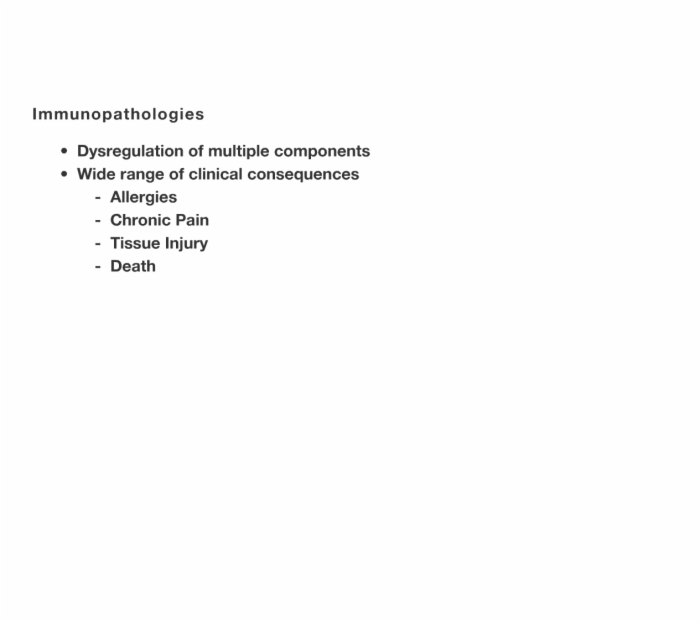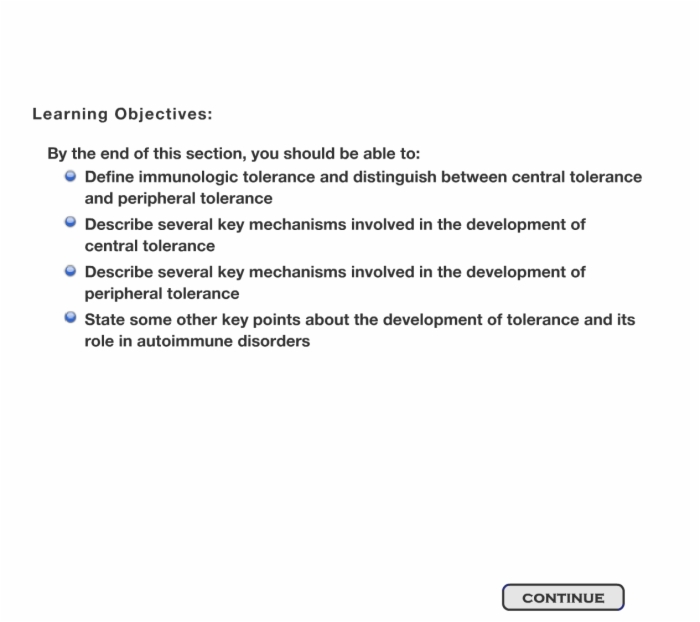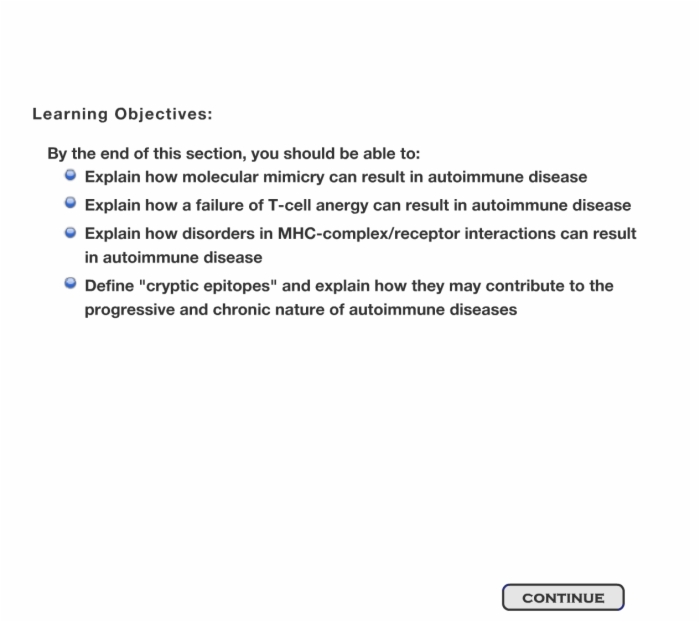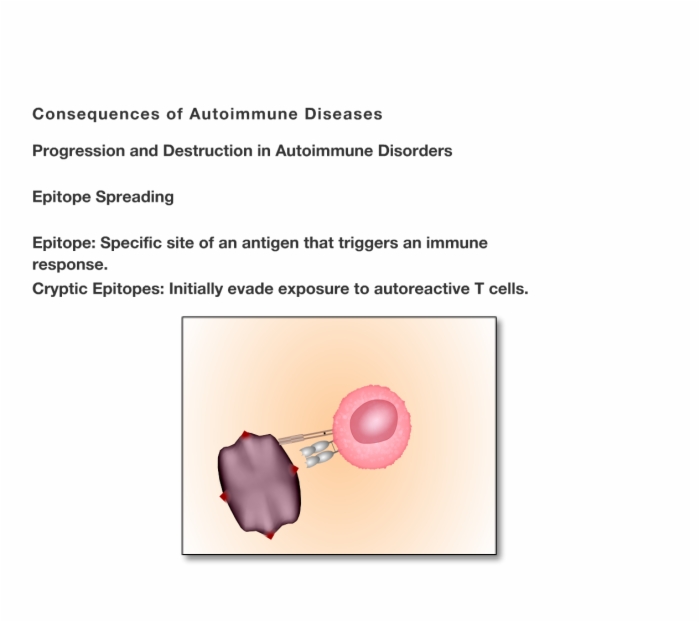SMi Source lesson Immunology: Immune System Pathology has the following microlearning topics
1. Introduction to Immunopathology

2. Key Concepts in Autoimmunity: The Importance of Tolerance

3. Mechanisms of Autoimmune Disease: The Breakdown of Tolerance

4. Autoimmune Disease Processes

Lesson Immunology: Immune System Pathology teaches these concepts
Immune System Pathology, Introduction to Immunopathologies, Organ Transplant Rejection: Class I MHC and Class II MHC Proteins
Immune System Pathology, Introduction to Immunopathologies, Organ Transplant Rejection: How the Immune System Distinguishes between “Self” and “Non-Self”
Immune System Pathology, Introduction to Immunopathologies, Organ Transplant Rejection: HLA Typing for Transplant
Immune System Pathology, Introduction to Immunopathologies, Organ Transplant Rejection: Introduction
Immune System Pathology, Introduction to Immunopathologies, Organ Transplant Rejection: Host-Versus-Graft Disease (HVGD) and Graft-Versus-Host Disease (GVHD)
Immune System Pathology, Introduction to Immunopathologies, Immunopathologies: Clinical Consequences
Immune System Pathology, Introduction to Immunopathologies, Immunopathologies: Categories
Immune System Pathology, Introduction to Immunopathologies, Hypersensitivity Disorders
Immune System Pathology, Introduction to Immunopathologies, Hypersensitivity Disorders: Type I Immediate Hypersensitivity
Immune System Pathology, Introduction to Immunopathologies, Hypersensitivity Disorders: Type II Antibody-Mediated
Immune System Pathology, Introduction to Immunopathologies, Hypersensitivity Disorders: Type III Immune Complex-Mediated
Immune System Pathology, Introduction to Immunopathologies, Hypersensitivity Disorders: Type IV T-Cell-Mediated (Delayed)
Immune System Pathology, Introduction to Immunopathologies, Autoimmune Diseases: Epidemiology and Impact
Immune System Pathology, Introduction to Immunopathologies, Autoimmune Diseases: General Mechanism Underlying Autoimmune Disease
Immune System Pathology, Introduction to Immunopathologies, Autoimmune Diseases
Immune System Pathology, Introduction to Immunopathologies, Autoimmune Diseases: The Spectrum of Attack
Immune System Pathology, Introduction to Immunopathologies, Immunodeficiency Syndromes
Immune System Pathology, Introduction to Immunopathologies, Immunopathologies (Knowledge Check)
Lesson Immunology: Immune System Pathology addresses these key points
MHC proteins:
- Are self antigens
- Display other antigens
- Were first identified on leukocytes
- Are also known as Human Leukocyte Antigens (HLA)
- There are two main classes that play a role in transplantation—MHC I and MHC II
Class I MHC:
- Expressed on virtually all nucleated cells
- Present antigens originating from inside of cells to CD8+ T cells
- HLA-A
- HLA-B
- HLA-C
Class II MHC:
- Expressed on Antigen Presenting Cells (APCs):
- Dendritic cells
- Macrophages
- B cells
- Present antigens originating from outside of cells to CD4+ T cells
- HLA-DR
- HLA-DP
- HLA-DQ
MHC proteins:
- ALL cells display MHC molecules
- MHC are highly variable proteins
- MHC from one individual unlikely to be similar to those in another person
Immune system distinguishes between:
- “Self” versus “Non-Self”
- Type of MHC proteins on the cell surface
HLA typing for transplant:
- The closer the HLA match, the lower the risk of rejection
- Three categories of HLA similarity:
- Autologous: The donor and the recipient are the same person
- Syngeneic: The donor and the recipient are identical twins
- Allogeneic: The donor and the recipient have similar HLA types, whether or not they are related
Organ transplant rejection:
- Immune system goal of eliminating “non-self”
- Advances in transplantation may come from new methods of immune system suppression
- Transplant rejection can be humoral or cell-mediated
- The immune reaction can be from the host or donor tissues
Organ transplant rejection:
- Process of transplant rejection:
- Cell-mediated immune responses
- Humoral immune responses
- HLA plays a key role in both immune responses
- Major categories of transplant rejection
- Host-Versus-Graft Disease (HVGD)
- Graft-Versus-Host Disease (GVHD)
Immunopathologies:
- Dysregulation of multiple components
- Wide range of clinical consequences
- Allergies
- Chronic pain
- Tissue injury
- Death
Over 100 immunopathologies have been identified. These include:
- Over 100 primary immunodeficiencies
- Around 80 autoimmune disorders
Immunopathologies can be grouped into four main categories:
- Hypersensitivity disorders
- Autoimmune diseases
- Transplant rejection
- Immunodeficiency syndromes
Hypersensitivity disorders:
- Excessive immune system activation
- In response to harmless antigens
- Can produce tissue injury or disease
- Autoimmune diseases and transplant rejections are classified as hypersensitivity reactions.
Type I hypersensitivity reactions:
- IgE-mediated
- Includes allergy and asthma
- Rapid development
Inflammatory effects:
- Blood vessel dilation
- Airway constriction
- White blood cell recruitment
Type II hypersensitivity reactions:
- IgG- or IgM-mediated
- Against cell surface antigen
Type III hypersensitivity reactions:
- IgG- or IgM-mediated
- Insoluble antigen-antibody complexes
- Indirect inflammation
Type IV hypersensitivity reactions:
- Do not involve antibodies
- T-cell-mediated
- Direct or indirect effects
- CD8+ direct cell cytotoxicity
- CD4+ delayed-type hypersensitivity reactions
Autoimmune diseases - epidemiology and impact:
- Third most common disease in the US
- Affecting 5-8% of the population (14-22 million people)
- Occur more often in women (78%)
- Occur in all ages
- Incidence varies with ethnicity
Immune response differences between men and women:
- Women:
- Increased antibody production
- Increased risk of autoimmune disease
- Men:
- More severe inflammation
- More severe disease
General mechanism underlying autoimmune disease:
- Loss of tolerance
- Inability to distinguish “self” and “non-self”
Tolerance:
- Is an active process
- Requires contact between self antigens and the immune system
Factors thought to play a role:
- Genetics
- Gender
- Environment
Autoimmune diseases:
- Breakdown in “self” vs. “non-self” discrimination
- ≥ 15 autoimmune disease
- Autoimmunity may be involved in > 80 conditions
- Wide range of diseases and variety of symptoms
- Can affect almost any part of the body
Autoimmune diseases - spectrum of attack:
- Single Organ: Antibody or cell-mediated response against antigens of a specific organ
- Systemic: Antibody-mediated, immune-complex-based pathology
Immunodeficiency syndromes:
- Abnormalities in the immune system that cause susceptibility to diseases that are normally prevented
- Classification of Immunodeficiencies:
- Immune system branch (dysfunction)
- Primary (inherited) vs. secondary (acquired)
Type 1 hypersensitivity:
- Excessive activation of the immune system following exposure
- Allergy, eczema, asthma
Autoimmune disease:
- Breakdown of self versus no-self recognition
- Rheumatoid arthritis and multiple sclerosis
Transplant rejection:
- Host versus Graft disease
- Cells from donor bone marrow attack cells of the host’s body
Immunodeficiency syndrome:
- HIV/AIDS
- An abnormality in one or more branches of the immune system that causes a person to be susceptible to infection
Lesson Immunology: Immune System Pathology is built from these main references. Log into SMi Source for a complete list and details.
Cotran et al. 1999
Porth 2005
Johnson et al. 1999
Janeway et al. 2005
NIH-ADCC 2002
Albert, 1999
Parham 2005
Yates et al. 2004
Introduction: Allergic and Other Hypersensitivity Disorders: Merck Manual Professional
Fairweather et al, The American Journal of Pathology. 2004, 2005, 2008, 2010
Tse et al. 2004
Davidson et al. 2001
Marieb 2004
Lesson Immunology: Immune System Pathology introduces and defines these terms
MHC = Major Histocompatibility Complex
HLA = Human Leukocyte Antigen
IgE = Immunoglobulin E
IgG/IgM = Immunoglobulin G/M